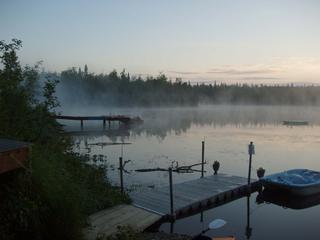
On Saturday I held my annual Pig Roast lakeside at Point Mackenzie, Alaska.
We cook a whole pig Polynesian style, using hot rocks a opposed to using a spit.
There a few differences in these two styles of cooking.
First and foremost is the equipment required to cook the pig. This year we cooked a 120 pound pig. This would require either the construction or rental of a very large roaster using the spit style of cooking. With the Polynesian cooking in the ground style, it simply requires more rocks.
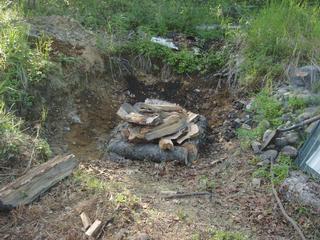 To start, you need a pit. My pit was created with a couple scoops from a backhoe while my driveway was being built. Alternatively, one can be dug by hand. It does not need to be deep, but should be big enough to allow people to get in on either side of the rock pile to work with the fire and pig.
To start, you need a pit. My pit was created with a couple scoops from a backhoe while my driveway was being built. Alternatively, one can be dug by hand. It does not need to be deep, but should be big enough to allow people to get in on either side of the rock pile to work with the fire and pig.We build the wood stack for the fire the night before the pig roast. The stack is built with an outside rectangle of rim logs to contain the fire. The bottom of the stack is lined with small fist-sized rocks, then the split wood is stacked in an inverted pyramid from the rim logs inward. A space on two opposing corners of the stack is left open for kindling; the fire is started at both corners.
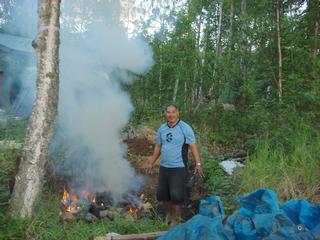 We cover the pit with a tarp over night and get a good nights rest; we start early in the morning!
We cover the pit with a tarp over night and get a good nights rest; we start early in the morning!This year I woke the guys at 5:00am to get started. We start the fire at both corners and then begin piling round river rocks sized between a fist and an ostrich egg on top of the fire.
In the photo to the left, my Samoan friend Joe is in the pit working the fire. Joe and I go a long way back as volleyball teammates. We aren't as young and spry as we once were, but we can still cook a pig.
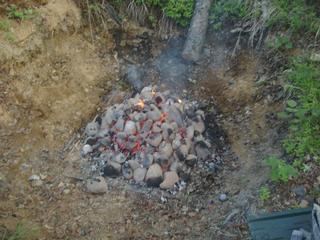 As the fire burns down, the hot rock pile accumulates between the rim logs. When the rocks are red hot, it is time to pull the remaining wood out of the fire.
As the fire burns down, the hot rock pile accumulates between the rim logs. When the rocks are red hot, it is time to pull the remaining wood out of the fire.Start by pulling out the rim logs and then remove each of the remaining burning logs.
This is hot work! The heat in the pit is incredible. You will need buckets of water at hand to douse the burning logs once they have been removed from the pit. Only the hot rocks should remain. The rocks are used to cook the pig. Make sure you use plenty of rocks; the more rocks, the more heat is generated to cook the pig.
Use a long stick (12 to 16 feet long) and a shovel to create a trench down the middle of the hot rocks for the pig.
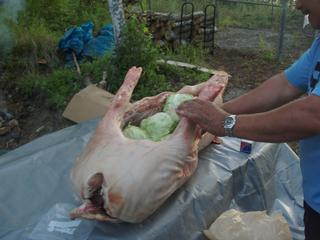 While the rocks are heating up, it is time to prepare the pig. We stuff the pig with whole heads of cabbage and yams wrapped in aluminum foil. We also rubbed the inside of the pig with fresh basil we grew at home in Wasilla. The pig is then wrapped in wire fencing lined with Aluminum foil. The wire fencing is important. Without this structure, you will not be able to lift the cooked pig back out of the pit; it will fall apart.
While the rocks are heating up, it is time to prepare the pig. We stuff the pig with whole heads of cabbage and yams wrapped in aluminum foil. We also rubbed the inside of the pig with fresh basil we grew at home in Wasilla. The pig is then wrapped in wire fencing lined with Aluminum foil. The wire fencing is important. Without this structure, you will not be able to lift the cooked pig back out of the pit; it will fall apart.The bundled pig is then set into the trench between the rocks. Using the stick and a shovel, the remaining rocks are placed around the sides of the pig, in the bundle and on top of the pig. Next we take sheets of aluminum foil and place them lengthwise across the pigs and rocks.
This is the place where, traditionally, you would cover the pig and rocks with banana leaves. These are a little hard to come by in South Central Alaska! Instead, we used wet newspapers. You will need a lot, so collect them over time in advance.
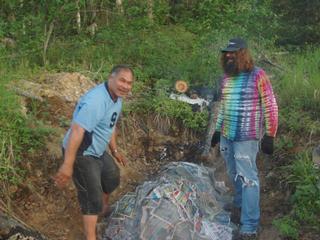
Soak the newspapers in a tub prior to application. Slap the news papers on the pig/foil/rock pile until the entire pile is covered in wet newspaper. It should resemble a huge paper mache monstrosity.
The resulting mound is then covered with a tarp to trap the heat and reflect it back to the pig. All of the edges of the tarp are buried in dirt to finish the heat seal. Keep burying the edges until there is no heat steam escaping from underneath the tarp. You do not need to completely bury the tarp.
After waking up at 5:00am, we had the rocks hot, the pig prepared, buried and cooking by 7:00am.
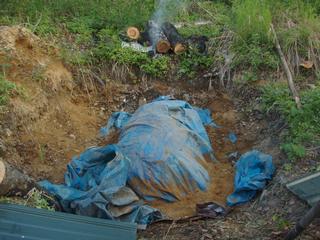 This is another area where this style of cooking differs from cooking a pig on a spit; The pig requires no further attention while it is cooking. We are now free to take a paddle on the lake, take a nap, or continue setting up the party until the pig is done.
This is another area where this style of cooking differs from cooking a pig on a spit; The pig requires no further attention while it is cooking. We are now free to take a paddle on the lake, take a nap, or continue setting up the party until the pig is done.With the amount of hot rocks we had, this pig should be fully cooked in about 6 hours. We did not pull the pig out until 2:30 because we wanted to wait until enough of the party goers had arrived and were ready to eat. This is another area where the two cooking styles differ; using the Polynesian style with hot rocks you cannot really over cook the pig. The pig is essentially steamed, so it comes out moist and tender.
To pull the pig out, remove the tarp, pull of the steaming hot newspapers (gloves recommended), grab the wire cage by each end and walk it out of the pit.
This Pig Roast and blog are sponsored by Business Application Developers professional software development and consulting for your business needs.
Aloha


Originally posted on 8/4/2010. Re-posted by request. I will be cooking another one this summer!
ReplyDelete